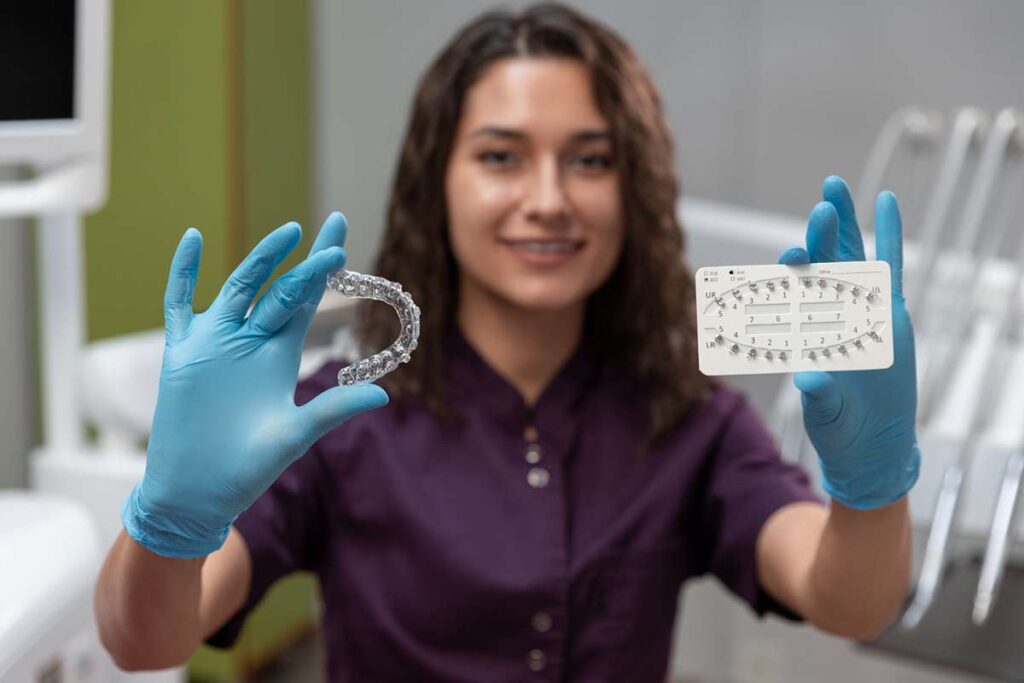Invisalign is a popular way to straighten teeth using clear, removable aligners instead of metal braces. Many people love how easy and comfortable they are. But if you don’t have dental insurance, you might wonder, how much is Invisalign without insurance? Costs can vary a lot, and it’s important to know what to expect before starting treatment. In this guide, we’ll break everything down in simple words to help you understand the true price of Invisalign without any confusion.
What Is Invisalign?
Invisalign is a special way to straighten your teeth without using metal braces. Instead of wires and brackets, Invisalign uses clear plastic trays called aligners. These trays fit over your teeth like a glove and slowly move them into the right spot. The best part? Most people won’t even notice you’re wearing them!
Compared to regular metal braces, Invisalign is smoother, more comfortable, and can be taken out when you eat or brush your teeth. With metal braces, you have to be careful with food and cleaning, but Invisalign gives you more freedom.
How Invisalign Works
Invisalign works step-by-step. First, your dentist or orthodontist takes a 3D picture of your teeth. Then, they design a custom plan just for you. You’ll get a set of clear aligners that you wear for about 20 to 22 hours a day. Every one to two weeks, you switch to a new set of aligners. Slowly, your teeth move into their perfect places without the pain or look of metal braces!
Why People Choose Invisalign Over Braces
Many people prefer Invisalign over regular metal braces, and it’s easy to see why. Invisalign offers a lot of benefits that make it a more comfortable and convenient choice, especially for adults and teens who care about their smile.
Here are some reasons why Invisalign is so popular:
- Comfort and Appearance:
Invisalign aligners are smooth and gentle on your gums and cheeks. They are clear, so most people won’t even notice you’re wearing them. - Removable Trays:
You can easily take the aligners out when you eat, drink, brush, or floss. This means you can enjoy your favorite foods without worrying about damaging braces. - Faster Results (Sometimes):
For simple cases, Invisalign can work faster than traditional braces. Some people finish their treatment in as little as 6 months!
How Much Is Invisalign Without Insurance?

If you’re wondering how much is Invisalign without insurance, the average cost usually falls between $3,000 and $8,000. But the exact amount you pay can change based on different factors.
Here’s a simple breakdown of typical Invisalign costs:
- Full Invisalign Treatment:
This is the standard plan for most people and usually costs between $3,000 and $8,000. - Invisalign Express:
This is a faster option for people who only need minor changes. It usually costs between $1,500 and $4,000. - Teen Invisalign:
Specially made for teenagers, this treatment usually costs between $3,000 and $7,000.
Why Do Invisalign Prices Vary?
Several things can make Invisalign more expensive or cheaper:
- Doctor’s Experience:
A highly experienced orthodontist may charge more for their skills and results. - Where You Live:
Big cities usually have higher prices compared to smaller towns. - Case Complexity:
If your teeth need a lot of movement or special care, the treatment might take longer and cost more.
Factors That Affect Invisalign Costs
The cost of Invisalign can vary depending on several important factors. Understanding these can help you get a clearer picture of why prices might be higher or lower in your case.
Here are the main factors that affect the cost of Invisalign:
Treatment Length:
The longer your treatment takes, the more expensive it might be. If your teeth require more movement or time to adjust, your cost will go up.
How Complicated Your Teeth Are:
If your teeth have a lot of misalignment or other issues, you might need more aligners or special treatment, which can increase the overall price.
Dentist’s or Orthodontist’s Fees:
More experienced dentists and orthodontists usually charge higher fees for their expertise. Choosing a highly skilled professional might cost a bit more, but it could also lead to better results.
Location (Big Cities = Higher Prices):
Where you live can make a big difference. If you live in a major city, prices tend to be higher than in smaller towns. This is because the cost of living and business overhead is usually more in larger areas.
Ways to Pay for Invisalign Without Insurance
If you don’t have insurance but still want to get Invisalign, there are several ways to make payments more affordable. Here are some options you can consider:
Payment Plans (Monthly):
Many dental offices offer monthly payment plans that break the total cost of Invisalign into smaller, easier payments. This option helps you avoid paying a large amount upfront and gives you the flexibility to pay over time.
Health Savings Account (HSA) or Flexible Spending Account (FSA):
If you have an HSA or FSA, you can use the money in these accounts to pay for Invisalign. These accounts allow you to save money tax-free for medical expenses, including dental care like Invisalign.
Dental Discount Plans:
Some companies offer dental discount plans, which can help you save on Invisalign and other dental treatments. These plans often require a membership fee, but they can give you significant discounts on various dental services.
CareCredit Financing:
CareCredit is a special type of financing that helps you pay for dental treatments, including Invisalign. It allows you to pay over time with low-interest or no-interest options, depending on the terms you choose.
Tips to Save Money on Invisalign
Invisalign can be expensive, but there are several ways you can save money while still getting the treatment you need. Here are some practical tips to help reduce the cost:
- Shop Around Different Providers:
Don’t settle for the first dentist or orthodontist you find. Compare prices from different providers in your area to find the best deal. Some offices may offer discounts or lower prices for the same quality of care. - Look for Promotions or Specials:
Many dental offices run special promotions throughout the year, like discounts or bundled offers. Keep an eye out for these deals, especially during holidays or special events, as they can help reduce the overall cost of your Invisalign treatment. - Consider Dental Schools Offering Discounts:
Dental schools often offer discounted Invisalign treatment. Students, supervised by experienced professionals, provide dental care at a lower cost. While the treatment might take a bit longer, it’s a great way to save money. - Ask About Free Consultations:
Some dental offices offer free consultations for new patients. Take advantage of this to get an idea of the costs involved and to see if the provider offers financing or payment plans that fit your budget.
Is Invisalign Worth It Without Insurance?

When it comes to straightening your teeth without insurance, you’ll want to weigh the pros and cons to decide if Invisalign is the right choice for you. Let’s break it down:
Pros of Invisalign Without Insurance:
- Comfort and Convenience:
Invisalign aligners are much more comfortable than traditional braces. You can remove them to eat, brush, and floss, which makes maintaining oral hygiene much easier. - Aesthetics:
Since the aligners are clear, they are far less noticeable than metal braces. This makes Invisalign a popular option for adults and teens who want to avoid the appearance of traditional braces. - Flexible Payment Options:
There are several ways to finance Invisalign without insurance, like monthly payment plans, HSAs, and CareCredit, which can make the cost more manageable. - Effective Results:
Invisalign can be just as effective as traditional braces for most people, with many achieving their desired results in a shorter time frame.
Cons of Invisalign Without Insurance:
- Cost:
Without insurance, Invisalign can be expensive, with prices ranging from $3,000 to $8,000. This can be a significant investment if you’re paying out of pocket. - Treatment Length:
While some cases may be completed in as little as 6 months, other cases might take longer, and that adds to the overall cost. The longer you need treatment, the more expensive it will be. - Not Suitable for All Cases:
Invisalign may not be the right solution for everyone. If your teeth require severe movement or if you have complex orthodontic issues, traditional braces might be a better option.
Think About Your Budget, Needs, and Goals
Before making a decision, consider your budget, your needs, and your long-term goals. If you’re looking for a comfortable and discreet treatment that fits your lifestyle and you’re able to manage the cost, Invisalign could be well worth the investment. However, if your budget is tight and you’re okay with the traditional look of braces, you may want to explore other affordable options.
Other Options if Invisalign Is Too Expensive
If the cost of Invisalign is too high for your budget, there are other effective options to straighten your teeth. Here are a few alternatives to consider:
Traditional Braces:
Traditional metal braces are usually the most affordable option for teeth straightening. While they’re more noticeable than Invisalign, they’re highly effective and work well for more complex cases. Metal braces are typically cheaper than Invisalign, making them a great choice if you’re on a tight budget.
Clear Braces:
Clear braces work like traditional metal braces, but with clear or tooth-colored brackets. This option offers a more discreet look while still providing the same reliable results. Clear braces are generally more affordable than Invisalign but can still be a bit more expensive than traditional metal braces.
At-home Clear Aligners (Candid, Byte, etc.):
At-home clear aligners like Candid, Byte, and SmileDirectClub offer a more affordable and convenient option. These aligners are delivered to your home, and you can manage your treatment from the comfort of your own space. While they might not work for everyone, they can be a great choice for people with minor alignment issues and a smaller budget.
FAQS
What is the lowest cost of Invisalign?
The lowest cost of Invisalign is typically around $1,500 for shorter treatments like Invisalign Express. However, the cost can go up depending on the complexity and length of the treatment.
How much does Invisalign cost in Pakistan?
In Pakistan, Invisalign costs approximately PKR 100,000 to PKR 350,000 depending on the type of treatment and the provider. Prices can vary based on the clinic and location.
Can I get Invisalign for free?
While Invisalign is rarely free, some dental offices offer free consultations or discounts during promotional periods. Be sure to check for local deals.
How much is one month of Invisalign?
One month of Invisalign treatment typically costs about $250 to $500, depending on the provider and the total treatment plan. This may be broken down into monthly payments.
Is Invisalign painful?
Invisalign may cause mild discomfort when switching to new aligners, but it’s generally less painful than traditional braces. The pain usually subsides after a few days.
Is Invisalign cheaper than braces?
Invisalign can sometimes be more expensive than traditional braces, but it depends on factors like treatment length and case complexity. In general, Invisalign offers more aesthetic benefits.
Why is Invisalign so expensive?
Invisalign is expensive due to its advanced technology, custom aligners, and the expertise required from orthodontists to monitor your progress throughout the treatment.
How much does Invisalign cost monthly without insurance?
Without insurance, Invisalign typically costs $100 to $250 per month if you opt for a payment plan. The total cost depends on the length of your treatment and your provider.
Does Invisalign offer payment plans?
Yes, Invisalign offers payment plans, which allow you to spread the cost over months or years. Many dental offices provide these flexible options to make the treatment more affordable.
Can I use my HSA or FSA for Invisalign?
Yes, you can use your HSA or FSA to pay for Invisalign. These accounts allow you to use pre-tax dollars, helping you save money on dental care.
Is it cheaper to pay for Invisalign upfront?
Sometimes, paying for Invisalign upfront can offer discounts or reduced overall costs. Some providers offer better rates for full payment in advance, saving you money in the long run.
Conclusion
Invisalign costs without insurance typically range from $3,000 to $8,000, depending on factors like treatment length, case complexity, and the experience of the provider. While it can be an expensive option, there are ways to save money, such as considering monthly payment plans, dental discount programs, or exploring financing options like CareCredit. If Invisalign is too costly, alternatives such as traditional braces or at-home aligners can offer more affordable solutions.
Remember, how much Invisalign costs without insurance varies from person to person, so it’s always a good idea to talk to a dentist or orthodontist for an exact quote. They can help you understand all your options and find a payment plan that works best for you.














